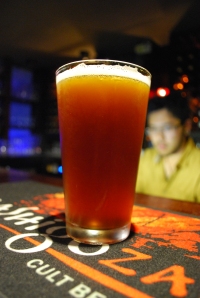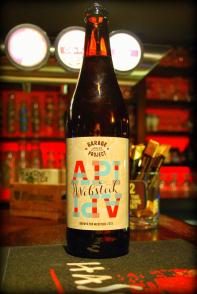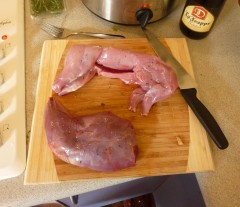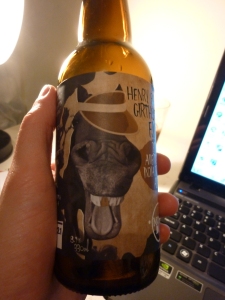As a barman, I meet all sorts. Customers are strange creatures, and recently I met a trio that inspired a fair deal of ambivalence in me. I’m not sure how best to explain the encounter, so I’m just going to take you thorough it as it happened.
So three men walk into a bar: an Englishman, an Englishman and an Englishman (sorry). They walk up to the bartender (me) and pull out a piece of paper.
“Hi there, we’re looking for some hard to find beers; thought this might be the place to find them,” said their spokesman. Certainly, said I. What are you after?
He consulted his list. “12 Gauge” (a strong lager from Leigh Sawmill Brewery). No, we don’t have it. Meow Cafe might have bottles of it. My mind races for an alternative New Zealand beer: tap pilsner? Liberty Alpha Dog?
He consults the list again. “Mammoth?” (Pink Elephant’s strong ale). Sorry, we don’t have that either. Hmm, Liberty High-Carb? I mentally store that recommendation away for the moment.
“Got any Engima?” Ah, Twisted Hop’s Barleywine! It hasn’t been brewed since the earthquake. We had a lot of the Red Zone version of it at one stage, but we sold out a while back. That beer’s extinct in the wild as it were. I know of a couple of bottles in captivity (private cellars), but none for sale. I explain all of this whilst digging around in my brain for a recommendation. Renaissance Tribute Barleywine. That’ll be perfect!
I’m about to recommend a Tribute, when he speaks again: “Emerson’s Old 95?” Ha. I should have seen that coming. That’s another extinct beer. Again, I know there are still bottles in captivity, but that hasn’t been brewed in almost two years. As I explain this, a thought occurs to me.
Where did you get this list I asked? It turns out he’d copied it out of the book 1001 Beers You Must Taste Before You Die. Now things are starting to make sense. That book was published in early 2010. Most of the writing was probably done in 2009 and the research for it as early as 2007-2008. Now that’s not long ago in the scheme of things, but with the radical growth of beer in New Zealand, five years ago was practically the Dark Ages.
Don’t believe me? Winter 2008 was the year Yeastie Boys launched with a single batch of Pot Kettle Black. They only did four releases in the year following, the second and third being Golden Boy and Kid Chocolate. The fourth was the second vintage (that’s right, vintage, it started as an annual release) of PKB.
Need more perspective? Late 2009 was the year 8 Wired launched, with a beer called “All of the Above.” Never heard of it? It was later re-named ReWired. I suspect the book would have been nearing completion at that stage, and no one who worked on it had ever heard of the virtuoso Dane, brewing in small-town New Zealand.
Anyway, so now I know what I’m dealing with. What else is on the list? Invercargill Smokin’ Bishop. Well, that’s a winter release. You’ll be lucky to find it this time of year. We have no other New Zealand equivalent, but maybe a Rex Attitude? Harrington’s Big John Special Reserve. Ah! If only we had some Double-Barrelled Cockswain’s on tap! Never mind, an 8 Wired Batch 18 will blow their minds, I think.
Look mate, I say, that book’s pretty out of date. Let me recommend some New Zealand beers I think should be in that book. “No thanks,” he says. “I’ll just have a look through your menu.” The three of them bury their heads in the bottle-list.
Ok, that’s odd. Well, clearly they’re experienced beer-hunters, so they know what they’re doing. Since I wasn’t busy, I grabbed the bar computer and had a quick dig. Hey mate, I said, it looks like Regional Wines and Spirits have bottles of Smokin’ Bish’ and Big John. They’re an awesome bottle shop not far from here, I can give you directions if you like.
He looks up. “No thanks. The rule is we have to drink them in an on-licence.” Um… What? Now I know it’s fun to make make arbitrary rules for simple tasks to make them more challenging; like say only stepping on black tiles when walking across a chequer-board floor. However to me, what he said was utterly-nutterly-butterly insane. Isn’t the point of beer-hunting that you go you go out of your way to try beers no matter how you get your hands on them? I have a friend who once on a trip to Germany, went out of her way to go to Bamberg, just because she liked Rauchbiers. Personally, I’ll walk across broken glass if I want a beer bad enough. It’s about the beer, not the method of acquisition: the why matters, not the how.
I was still digesting this revelation when he finally ordered beers: three Rising Sun Pale Ales. Um, wait, what the fuck? These guys have come all the way around the world hunting specific New Zealand beers, to probably the best beer-bar in the country. When they can’t find them what do they do? Drink imports. From snatches of their conversation, I gathered at least one of them had already had Baird beer before, in Japan! Hashigo is probably the only bar in the country that still has Batch 18, but you’re drinking imported beer you’ve had before?
Ok, chill out. I begrudge no one their tasty beverage. Clearly these guys know what they like and like good beer. Except…
They came back the next day and drank Chimay and Rochefort. What? Really? Two (admittedly beautiful) Trappist beers that can be found in almost any beer-bar world-wide?
Alright, fine. So you know what you want (god-bless you for that). But readers might see why I’m a little perplexed here. The point of international beer-hunting is that you go to a place and seek-out the beers that come from there. Heavens knows I flout the ‘drink local’ ethos almost daily, but if I’m travelling somewhere, I want to try the beers I can’t get anywhere else.
I can’t help feeling like these chaps have lost sight of the wood because of all the pesky trees that keep getting in the way. They came all this way to not try local beers because they weren’t on an obsolete list? I suspect a Pokemon1 mentality has take over here: the act of collecting, the ‘Gotta Catch ‘Em All’ has become more important than the actual thing you’re collecting.
I’m going to finish by saying two things:
First of all, I like your style. The enthusiasm and dedication of going around the world trying beers everywhere is something I applaud. But also keep in mind that beer is a fluid thing (literally and metaphorically): breweries fail and change hands, new beers are created and new breweries start-up. Books don’t change though. The 1001 is fixed in history, so you’re doomed to failure. You will probably never taste Old 95. With that in mind, don’t lose sight of what beer-hunting should be about: enjoying good beer, in good places, with good people.
So yeah, keep that in mind. And god-speed, you mad bastards.
- For those mature readers unfamiliar with Pokemon, it was a cartoon/trading card/videogame series where people imprison animals in ludicrously small cages and then sic them on random strangers. Imagine a blend of stamp-collecting and dog-fighting and you’re pretty much there.














